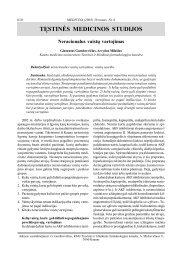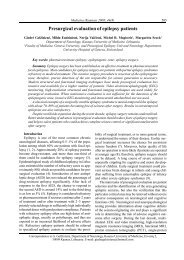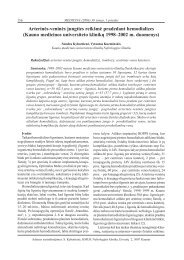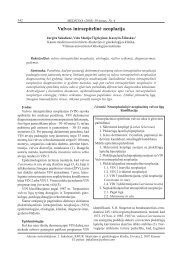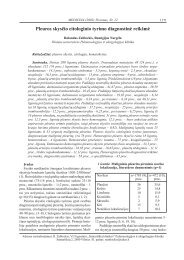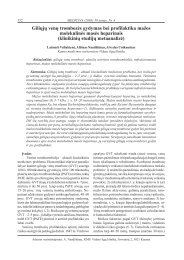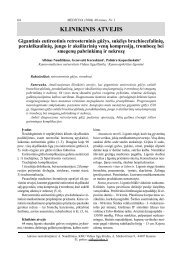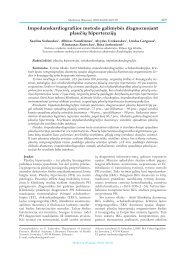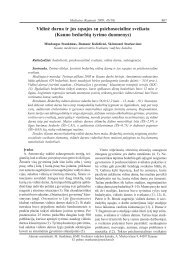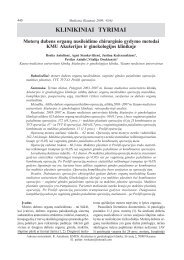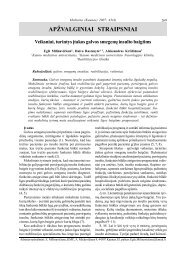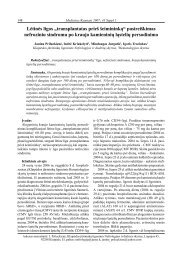Periferinių arterijų liga - Medicina - kmu
Periferinių arterijų liga - Medicina - kmu
Periferinių arterijų liga - Medicina - kmu
Create successful ePaper yourself
Turn your PDF publications into a flip-book with our unique Google optimized e-Paper software.
334<br />
gas, progresuojant PAL simptomatikai, taikomos<br />
endovaskulinės intervencijos, atliekamos revaskulizacijos<br />
operacijos. Kai PAL įsisenėjusi, reikia skirti<br />
skausmą malšinančių medikamentų, o atsiradus komplikacijoms<br />
(opoms, gangrenai), ir antibakterinių vaistų.<br />
Išvados<br />
1. PAL yra paplitusi patologija. Ši <strong>liga</strong>, remiantis<br />
klinikinių tyrimų duomenimis, pažeidžia nuo 10 iki<br />
30 proc. visų gyventojų. Būdingi protarpinio šlubavimo<br />
simptomai pasireiškia tik vienam trečdaliui pacientų,<br />
o daugeliui <strong>liga</strong> pasireiškia be simptomų.<br />
2. Rizikos veiksnių, pvz., rūkymo metimas, lipidų<br />
apykaitos sutrikimų korekcija, laiku pradėtas cukrinio<br />
diabeto gydymas apsaugo nuo PAL komplikacijų.<br />
3. PAL ligą galima vertinti kaip nepriklausomą<br />
išeminės širdies ligos rizikos veiksnį. PAL sergantiems<br />
pacientams širdies infarkto rizika yra 2–3 proc. per<br />
metus, o krūtinės anginos priepuoliai yra 2–3 kartus<br />
dažnesni nei įprasta tokio amžiaus žmonių grupei.<br />
4. KŽI yra neinvazinis ir paprastas tyrimo metodas,<br />
lengvai prieinamas pirminėje sveikatos priežiūros<br />
grandyje, kuriuo galima diagnozuoti ir kontroliuoti<br />
PAL. Tyrimo jautrumas ir efektyvumas – iki 100 proc.<br />
Peripheral arterial disease – an underappreciated clinical problem<br />
Edita Mašanauskienė, Albinas Naudžiūnas<br />
Department of Internal Diseases, Kaunas University of Medicine, Lithuania<br />
Key words: atherosclerosis; peripheral artery disease; ankle-brachial index.<br />
Summary. Peripheral artery disease is a common vascular disorder. In contrast to coronary and cerebral<br />
artery disease, peripheral arterial disease remains an underappreciated condition that despite being serious<br />
and extremely prevalent is rarely diagnosed and even less frequently treated. Early diagnosis of peripheral<br />
artery disease and individual assessment of risk factors are important in preventing further cardiovascular<br />
complications. The ankle-brachial index is a simple, reliable tool for diagnosing peripheral artery disease.<br />
Many studies underscore the importance of using the ankle-brachial index to identify persons with peripheral<br />
artery disease, since peripheral artery disease is frequently undiagnosed or asymptomatic. Measurement of<br />
the ankle-brachial index is simple enough to be performed in any doctor’s office, and it is one of the most<br />
reliable indices of peripheral artery disease.<br />
Correspondence to E. Mašanauskienė, Department of Internal Diseases, Kaunas University of Medicine, Eivenių 2,<br />
50009 Kaunas, Lithuania. E-mail: edita.masanauskiene@gmail.com<br />
Literatūra<br />
1. TASC II Inter-Society Consensus for the Management of<br />
Peripheral Arterial Disease. Eur J Vasc Endovasc Surg 2007;<br />
33(Suppl 1):S1-40.<br />
2. Steg PG, the REACH Registry Investigators. One-year<br />
cardiovascular event rates in outpatients with atherothrombosis.<br />
JAMA 2007;297(11):1197-206.<br />
3. AHCPR. United States Department of Health and Human<br />
Services. Agency for Health Care Policy and Research. Acute<br />
pain management: operative or medical procedures and<br />
trauma. Rockville, MD: AHCPR; 1993. p. 107.<br />
4. Criqui MH, Fronek A, Barrett-Connor E, Klauber MR, Gabriel<br />
S, Goodman D. The prevalence of peripheral arterial disease<br />
in a defined population. Circulation 1985;71(3):510-51.<br />
5. Clement DL, Boccalon H, Darmandy J, Durand-Zaleski I,<br />
Fowkes G, Brown T. A clinical approach to the management<br />
of the patient with coronary and/or carotid artery disease who<br />
presents with leg ischemia. Int Angiol 2000;19(2):97-125.<br />
6. Hirsch A, Criqui M, Treat-Jacobson D, Regensteiner J,<br />
Creager M, Olin J, et al. Peripheral arterial disease detection,<br />
awareness, and treatment in primary care. JAMA 2001;<br />
Edita Mašanauskienė, Albinas Naudžiūnas<br />
286(11):1317-24.<br />
7. Selvin E, Erlinger TP. Prevalence of and risk factors for<br />
peripheral arterial disease in the United States: results from<br />
the National Health and Nutrition Examination Survey, 1999–<br />
2000. Circulation 2004;110(6):738-43.<br />
8. Bhatt D, Steg P, Ohman E, Hirsch A, Ikeda Y, Mas J, et al.<br />
International prevalence, recognition, and treatment of cardiovascular<br />
risk factors in outpatients with atherothrombosis.<br />
JAMA 2006;295:180-9.<br />
9. Kullo IJ, Bairey KR, Kardia SL, Mosley Jr TH, Boerwinkle<br />
E, Turner ST. Ethnic differences in peripheral arterial disease<br />
in the NHLBI Genetic Epidemiology Network of Arteriopathy<br />
(GENOA) study. Vasc Med 2003;8(4):237-42.<br />
10. Fowkes FG, Housley E, Cawood EH, Macintyre CC, Rucley<br />
CV, Precott RJ. Edinburgh Artery Study: prevalence of<br />
asymptomatic and symptomatic peripheral arterial disease in<br />
the general population. Int J Epidemiol 1991;20(2):384-92.<br />
11. Selvin E, Marinopoulos S, Berkenblit G, Rami T, Brancati<br />
FL, Powe NR, et al. Meta-analysis: glycosylated hemoglobin<br />
and cardiovascular disease in diabetes mellitus. Ann Inter Med<br />
2004;141(6):421-31.<br />
<strong>Medicina</strong> (Kaunas) 2008; 44(4)



